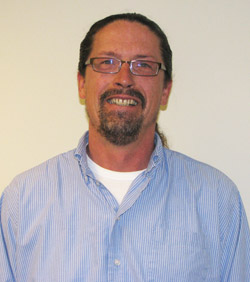By Libby Schultz

Keith Holmstrom, northwest region radio maintenance supervisor. Photo courtesy of District 4 |
Radio Communications is defined as the transmission and reception of voice or data signals travelling through free space. These electronic communications allow MnDOT maintenance staff to communicate with one another, as well as personnel from other state and local agencies.
Keith Holmstrom, northwest region radio maintenance supervisor, is charged with making sure all electronic communications are maintained and running smoothly in the northwestern area of the state. His current workload centers around the ongoing implementation of the state’s new Allied Radio Matrix for Emergency Response system—a shared public safety radio communication system.
Holmstrom has worked in the Office of Electronic Communications for almost 24 years, serving the last six as supervisor of the northwest region team, which consists of 11 radio technicians, two Road Weather Information System technicians, one Labor Trades and Equipment employee and one ARMER radio engineer. The team serves facilities in Detroit Lakes, Crookston, Thief River Falls, Bemidji and Baxter.
Where do you spend most of your time?
I’ve worked my entire career in District 4/Detroit Lakes, but I am technically a Central Office employee out of the Water’s Edge facility in Roseville.
How is radio communications different from other communications departments at MnDOT?
We are quite unique in comparison because we are responsible for the installation and service of the wireless communications for almost all departments in the state. Our communications is electronically based, which usually consists of a two-way radio mounted in some type of motor vehicle where the operator of that motor vehicle has the ability to communicate with other co-workers and dispatchers via radio towers that are strategically located throughout the state.
What do you do on a daily basis?
Currently, we are undergoing a complete transformation of our old analog VHF radio system to a digital trunked radio system known as ARMER. This transformation occupies most of our time at this point. The largest part of the transformation is the construction of additional radio towers to provide 95 percent radio coverage throughout every county in the state. When complete, the northwest region will have around 100 radio towers.
Every member of my team plays a vital role on a daily basis to achieve our goal to decommission the VHF radio system by the end of 2012. With the help of our engineering staff from the Roseville office, we are all involved in updating our older tower sites to support the trunked radio system and also support the construction of the new tower sites. This may include tower site construction location, site layout, site inspections, ARMER system equipment installations, then finally putting the site “on the air” and ready for use.
What is a challenge you’ve faced at your job?
A few years ago, we received permission from a land owner to construct a new tower site on his private property and had nearly completed the purchase process when we were met with a coalition of neighbors that didn’t want a tower at that location. We had a town hall meeting scheduled in hopes that we would be able to meet those that opposed the location so we could learn what the issues were. As it turned out, Mother Nature had a different plan. We were there as the state’s representatives, but because of the weather, hardly anyone else showed up, including all of the opposition. After listening to their concerns and considering their recommendations, we all agreed to a new location that was suitable to all involved.
What would you like people to know about your job?
I would like people to know that the Federal Communications Commission has mandated the conversion to narrow band by the year 2013. With this mandate, the state is changing the radio system. It was decided to pursue a trunking system in the 800MHz band that is now referred to as ARMER.
Some of the departments within the state that utilize the ARMER system are MnDOT, State Patrol, DNR and the BCA, just to name a few. With the ARMER system, a common resource was provided that not only state departments would utilize, but all public safety entities across the state.
At times of crisis across the state, like a forest fire, flooding or a large scale catastrophe where multiple agencies from all over the state respond, it is now possible to have radio communications with everyone involved.
Do you or a co-worker have an interesting job to share with readers? Click here to send us your ideas, and we’ll contact you for more information.
Recent employee profiles:
|



